1lumen selects and reviews products personally. We may earn affiliate commissions through our links, which help support our testing.
Fenix HT32 review
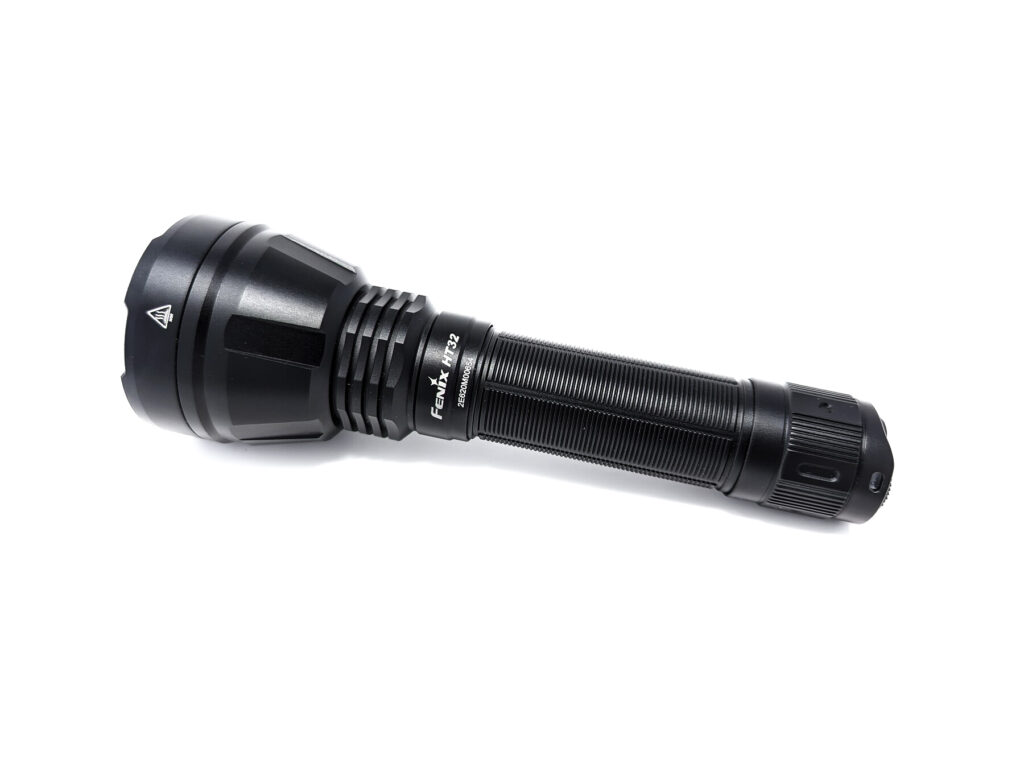
Fenix HT32 specs
| Brand & Model | Fenix HT32 |
|---|---|
| Flashlight category | Hunting |
| LED | Luminus SFT70, Luminus SFT20 |
| Max. output | 2500 lumens |
| Max. beam distance | 640 meters |
| Max. beam intensity | 101,000 cd |
| Battery config. | 1x 21700 |
| Onboard charging | No (built into the battery) |
| Main modes | 4 white, 2 red, 2 green |
| Blinkies | Strobe |
| Waterproof | IP68 |
| Review publication date | October 2023 |
Review intro:
Fenix makes a huge array of lights. In fact, they have an actual PDF catalog on their website (I imagine it’s probably also distributed in paper form as well) that is 48 pages long and chock-full of products ranging from tiny EDC lights all the way up to a couple really big boys that I’ve been fortunate enough to check out: the Fenix LR50R 12,000 lumen monstrosity and the Fenix HT30R 1500m throw LEP. If you need a light, chances are that Fenix will have a nice offering to fill that need.
By and large, I really like Fenix – my first “real” flashlight was a Fenix (the 187 lumen E25 model, if you’re curious). From my experience, Fenix lights are really well designed, they use quality materials and finishes, have great constant-current drivers, and publish truthful ANSI specs. I’ve had the opportunity to review several Fenix flashlights over the past few years – all were very nice lights. Today I’m reviewing the new Fenix HT32, an entry in Fenix’s Hunting series. It features red and green output in addition to the white LED. I’ve seen several different ways of switching light colors in a hunting flashlight, and the HT32 is pretty unique – read on to find out more.
Getting started with the Fenix HT32 is pretty straight-forward: remove the flashlight from the box, unscrew the battery tube, and remove the little insulator disc. Put the battery & tube back on and you’re good to go!
Package quality.
The packaging for the Fenix HT32 is instantly recognizable as having come off the same line as the other Fenix models that I recently reviewed. They used the exact same design language and materials: a showy black and orange carton with a heavy duty plastic tray inside. I think it’s great that Fenix is using consistent packaging as it helps drive brand recognition. Arranged in the tray was:
- Fenix HT32
- Battery (ARB-L21-5000U, pre-inserted)
- Charging cable
- Spare o-ring
- Holster
- Lanyard
- Manual and other literature
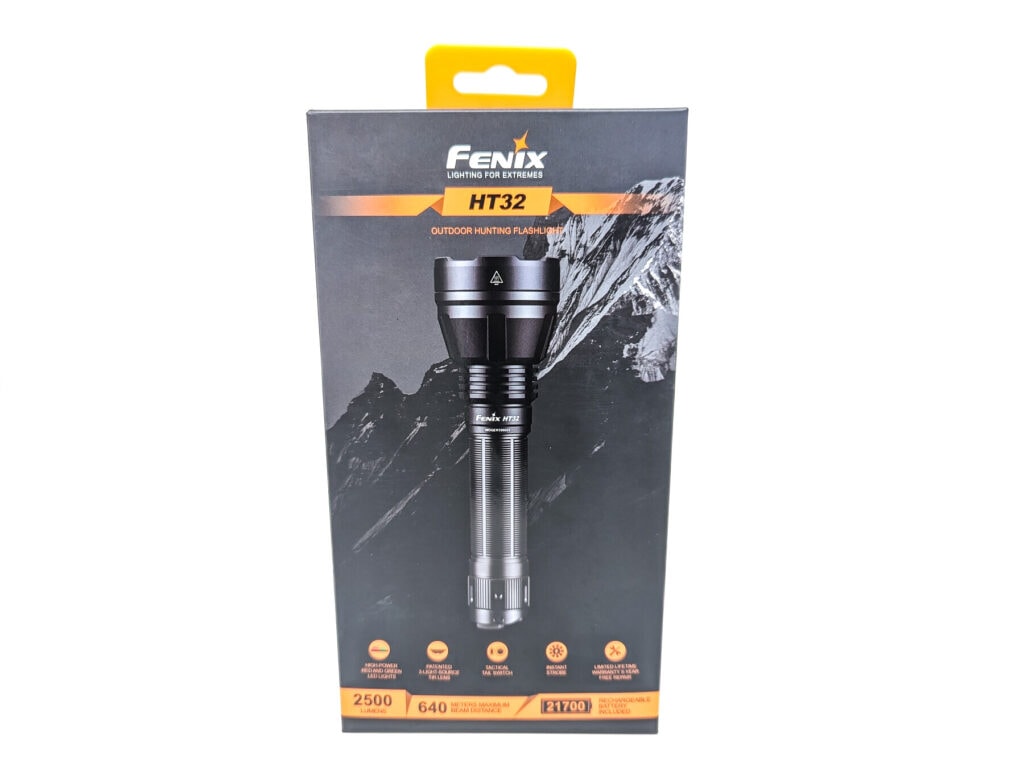
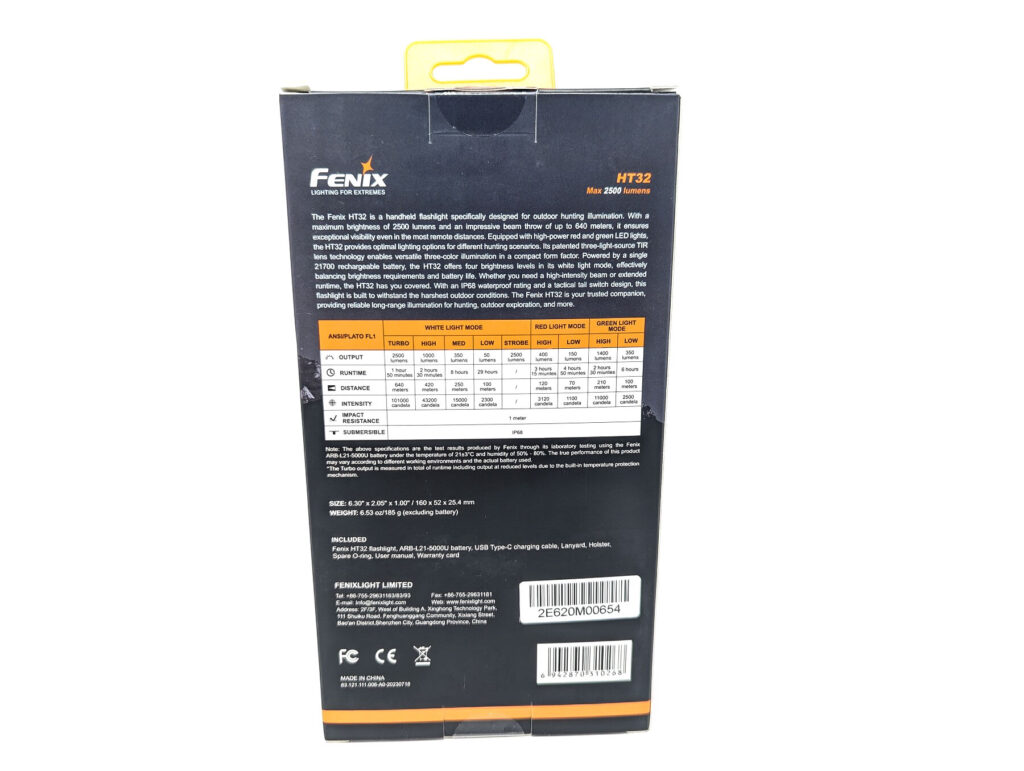
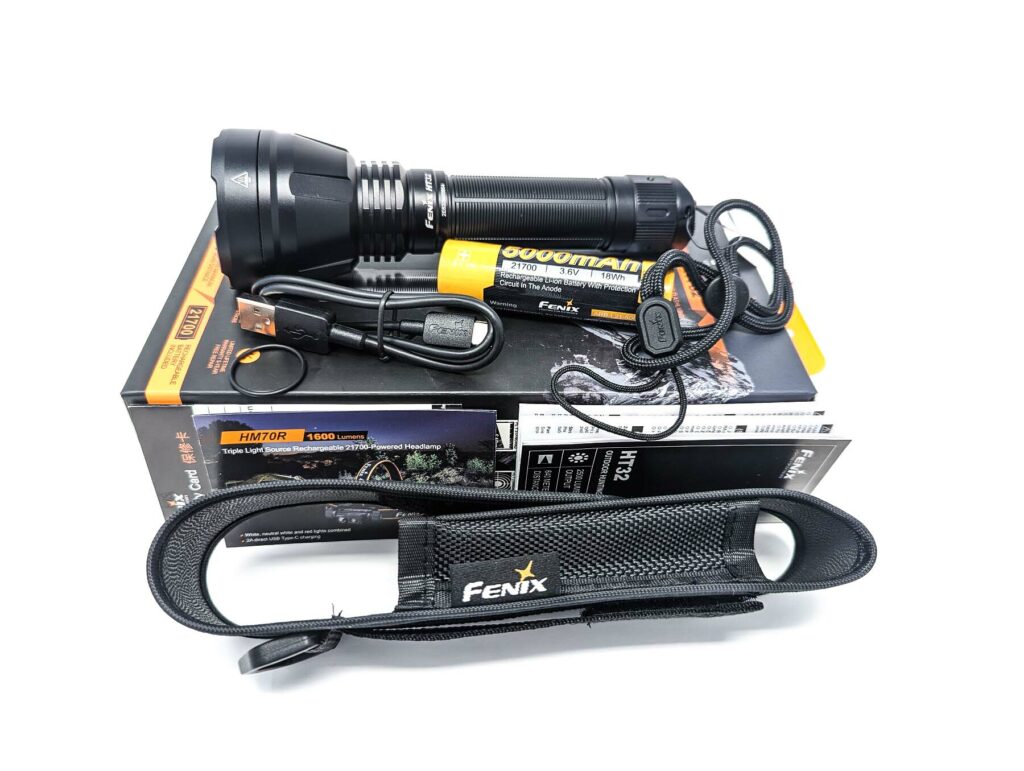
Flashlight in use, Build Quality, and Warranty
The Fenix HT32 is a purpose-built hunting flashlight, though I would say it’s right at home for many other outdoor activities. As far as size and shape go, the HT32 is a nice midsize light and traditional shape – like a smoother big brother to the ubiquitous flashlight C8 body. This Fenix could ride comfortably in a jacket pocket, but is too large for pants pockets, generally speaking. The HT32 comes with a standard-issue lanyard, and a nice quality holster, as is common with Fenix lights. The holster is a handy option, given that the flashlight is a bit too big for pants pockets.
The body is fairly round and could roll off the table if left on its side. Tailstanding is not an option, due to the tactical-style tailcap. The tail is designed like many tactical lights: a large forward-clicky switch for on-off duties, and a smaller, angled e-switch for mode changes. While this arrangement is physically similar to a tactical flashlight, the UI is distinctly different for the sake of hunting – that is to say, it employs mode memory.
Like many hunting-oriented flashlights, the Fenix HT32 puts out white, red, and green light. There are 3 distinct LEDs situated in an unique TIR lens, which eliminates the need for filters, module switching, or any moving parts – I’ll talk more about that in a minute. Depending on your use case, I really like this arrangement because the last thing I want to do when I’m out in the field (or woods) is to be scrounging around for a filter lens or opening up my flashlight to change modules. Being able to switch between color channels with the press of a button is a welcome change.
Warranty:
- 15 days from date of purchase: replacement from Fenix for manufacturing defects
- 5 year from date of purchase: free repairs
- Lifetime maintenance, with customer covering the cost of parts
- Extra 6 month warranty period for products registered on Fenix’s website
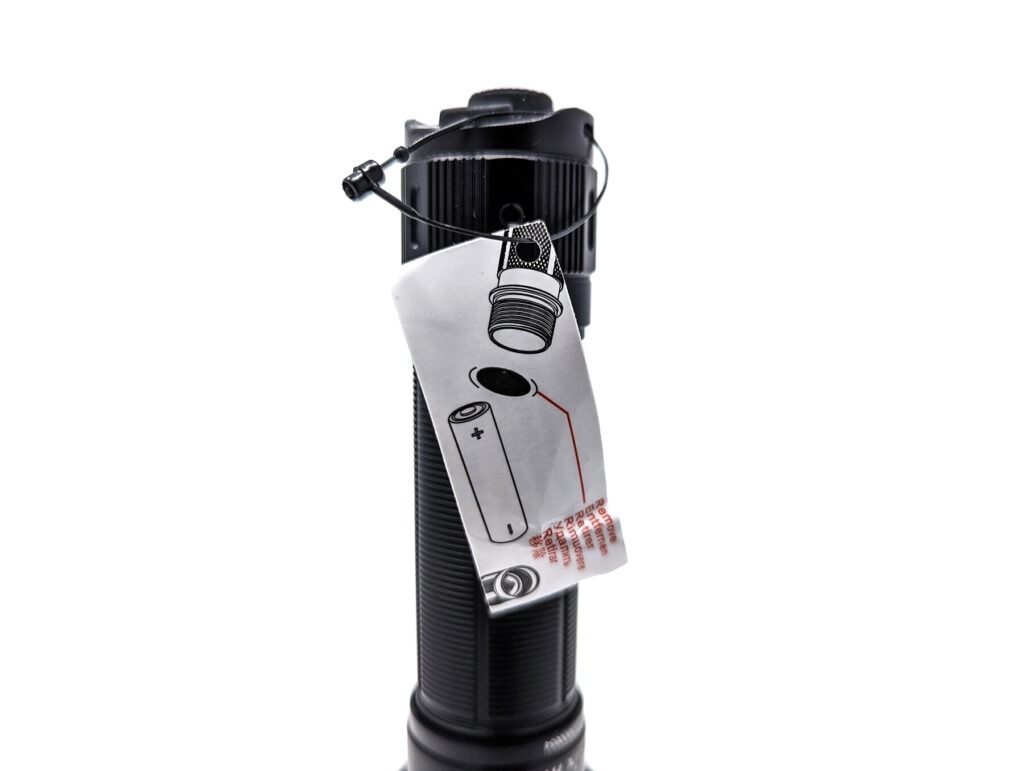
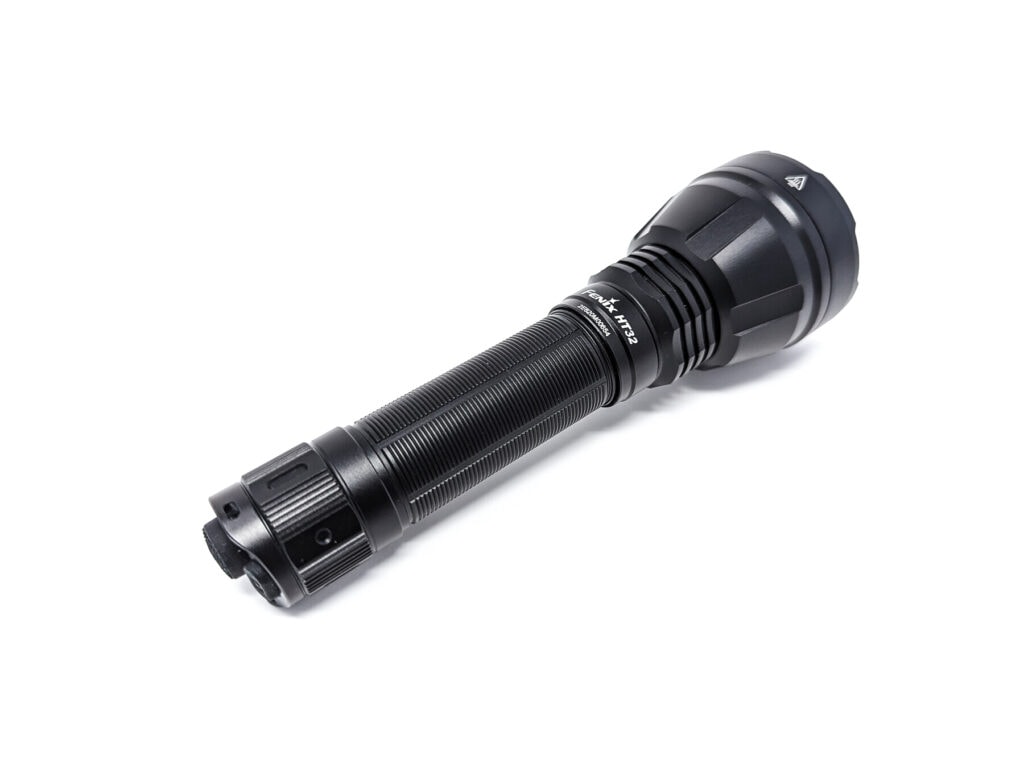
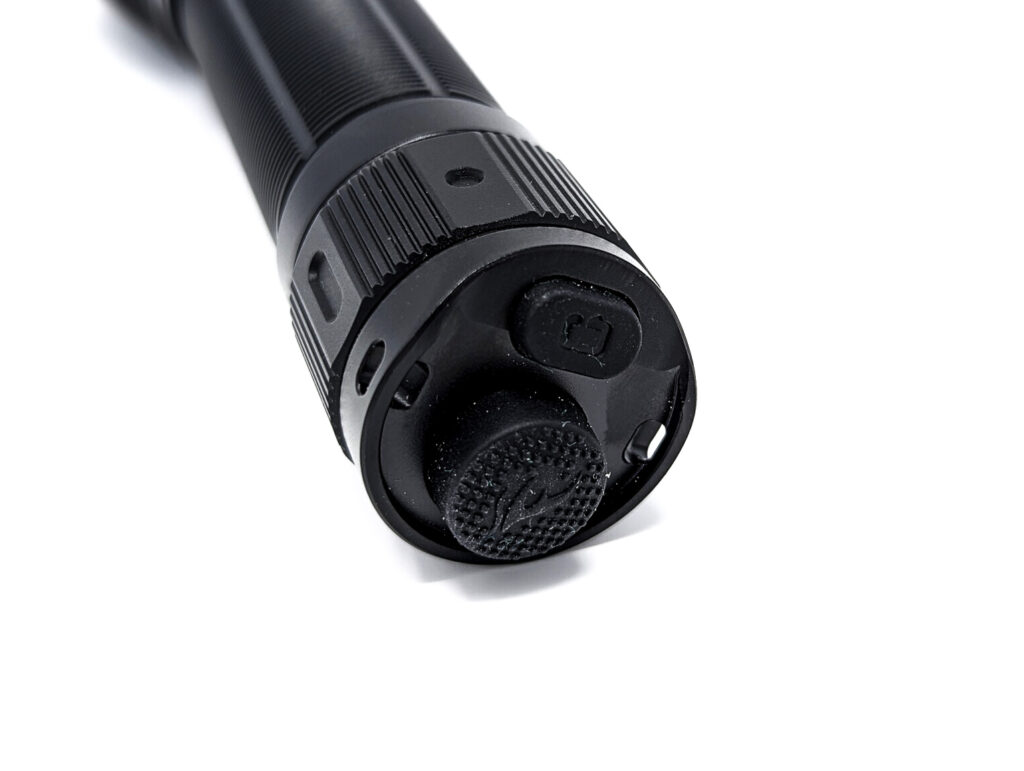
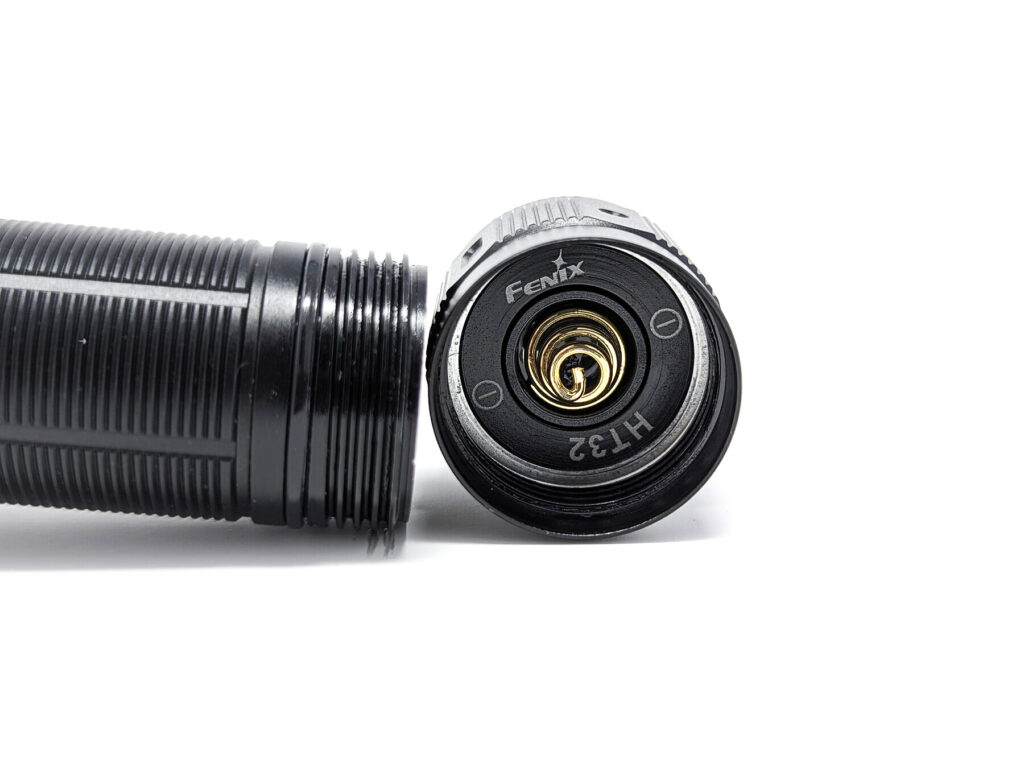
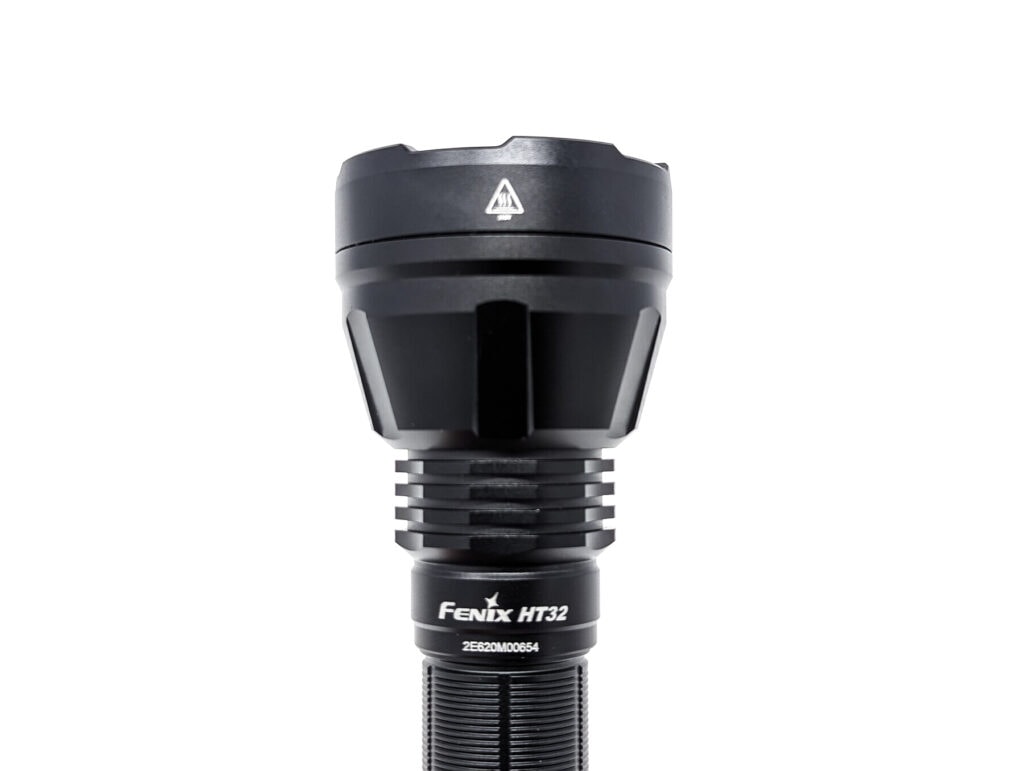
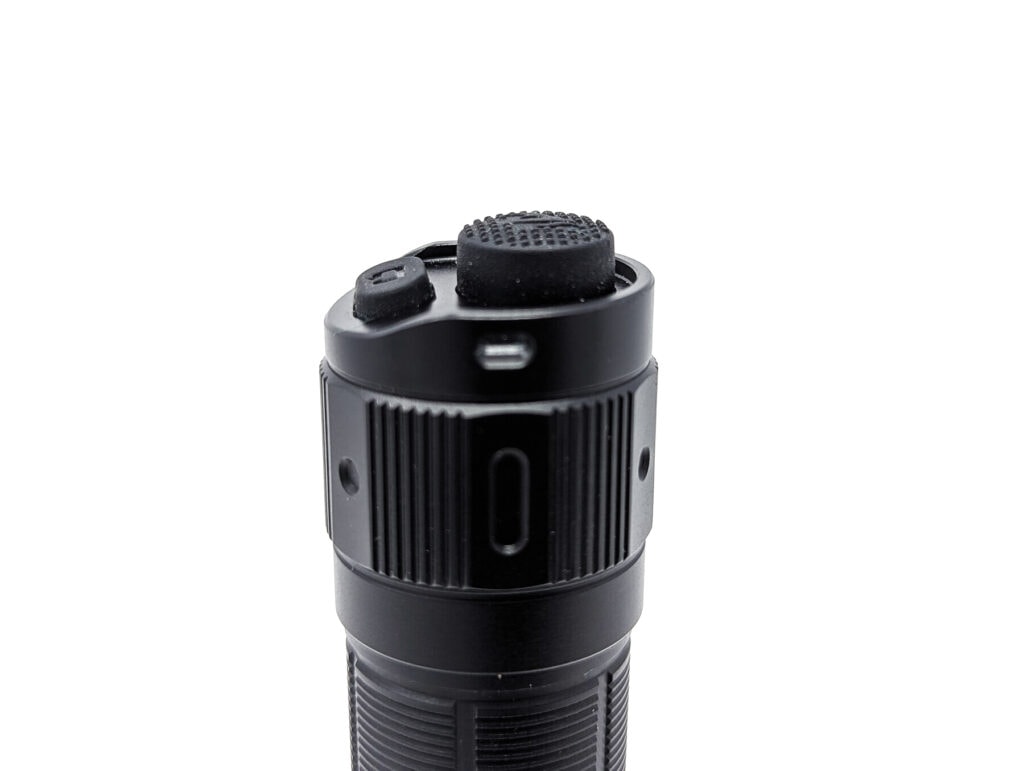
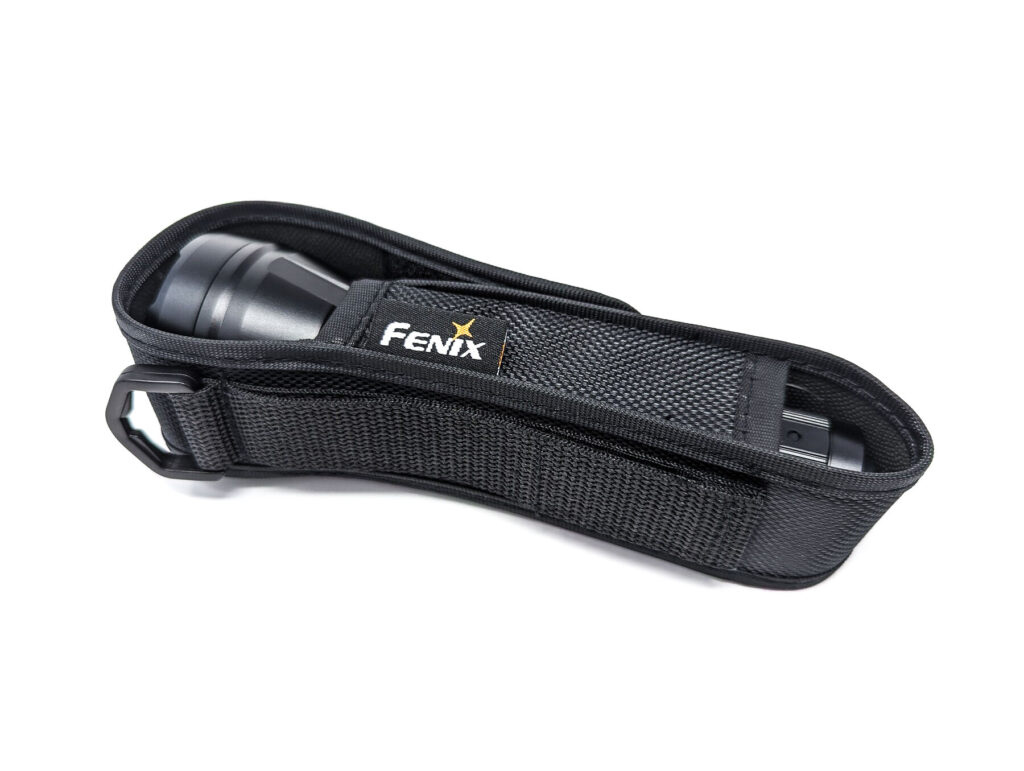

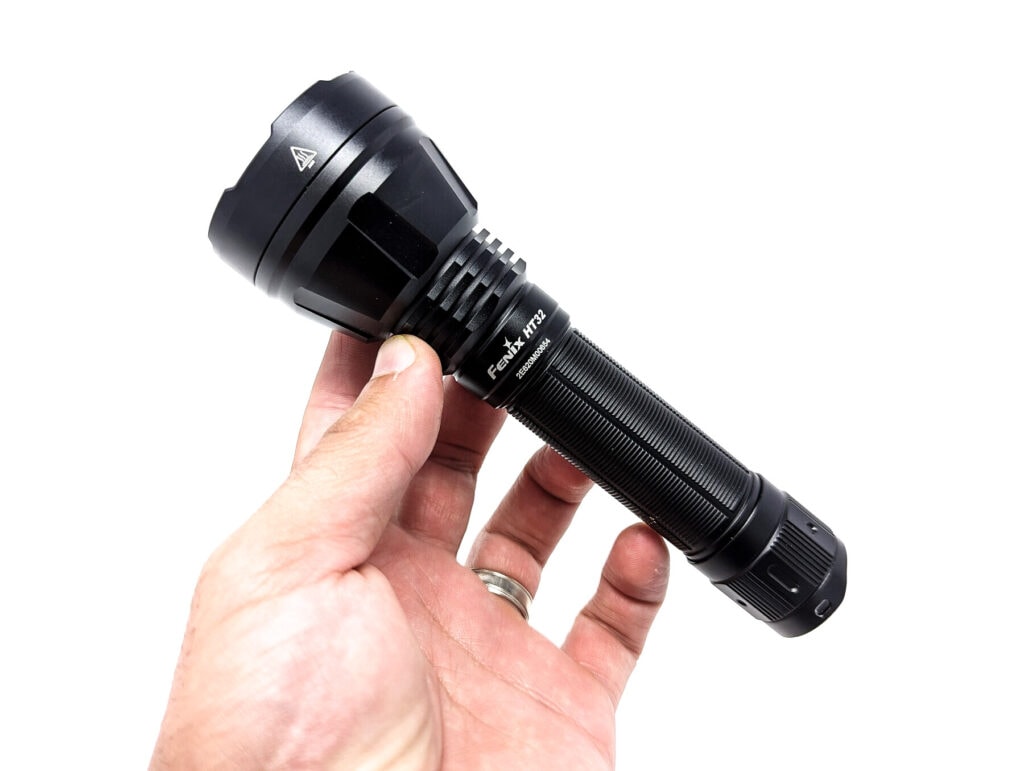
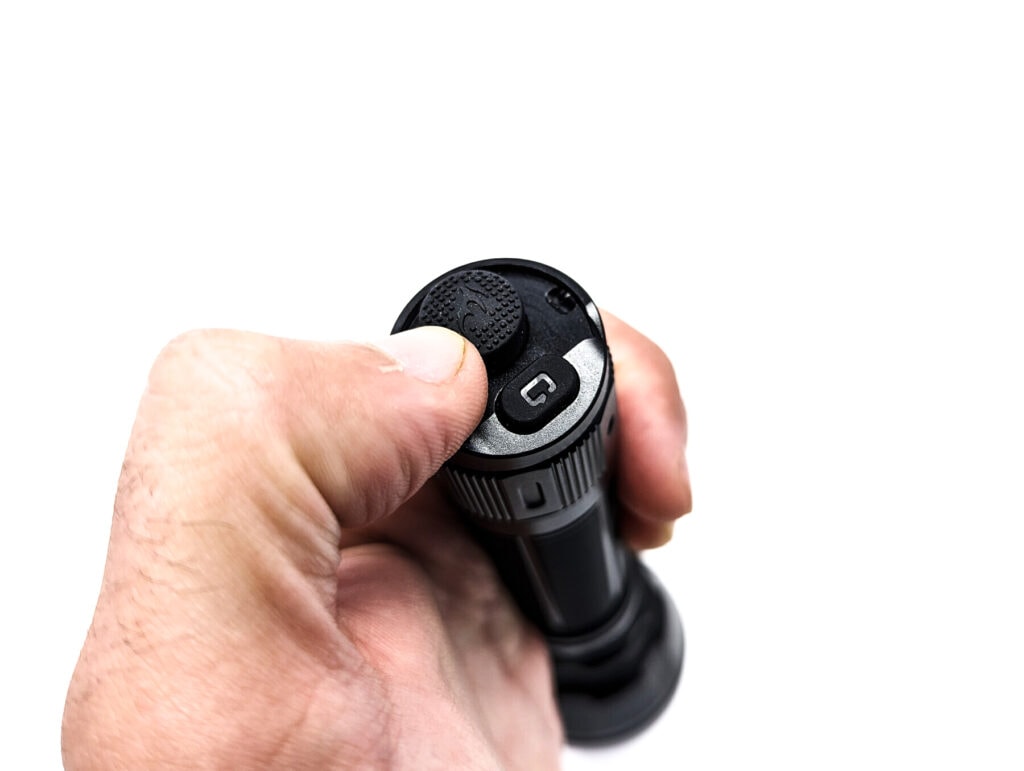
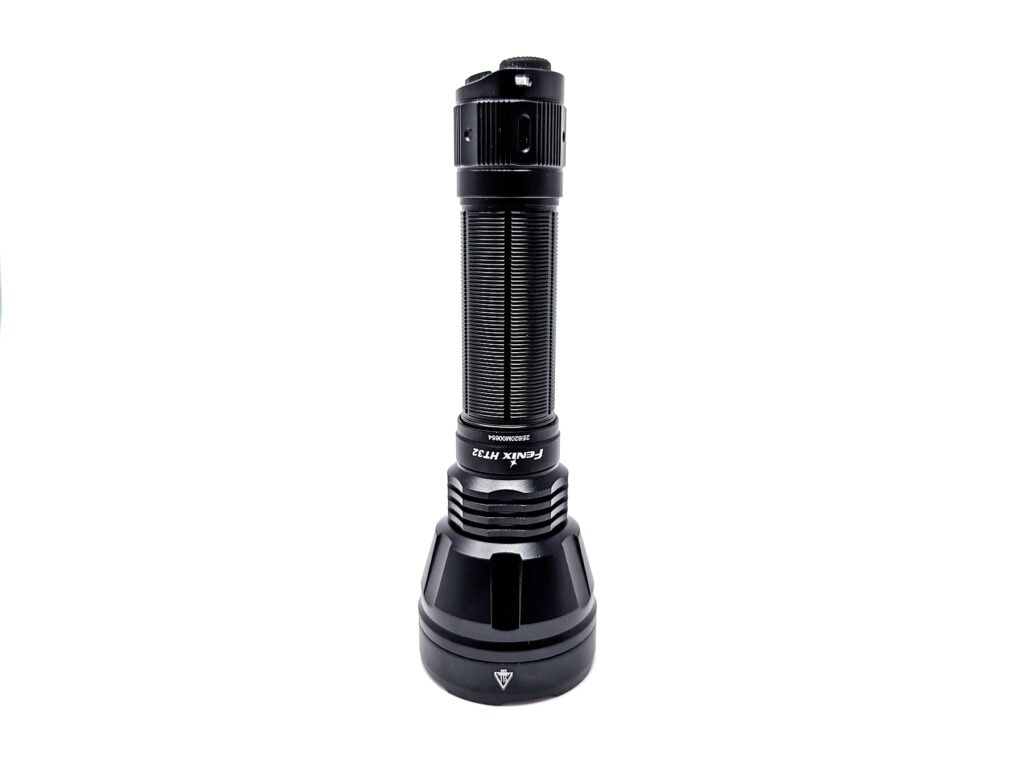
LED, Lens, Bezel, Beam, and Reflector
The commonality amongst hunting flashlights is having different color options, usually red and/or green in addition to white. This is because certain animals don’t “spook” as much with red or green, depending on the species. And even for homosapiens, red and green can help preserve night sight. I’ve seen several methods over the years for switching colors. Originally (especially before LEDs) this was accomplished with filter lenses fitted over the bezel. Then I began seeing swappable LED modules (like the Brinyte B158 or Speras TH12). Those are ok, but filters decrease your usable output and LED modules require you to open up your flashlight. Then there are flashlights with multiple reflector openings (like the Brinyte B21 Complex or Wurkkos WK30), but those generally sacrifice throw in order to make room for the separate reflector cups. Finally, Cyansky has come out with some really unique offerings: the H5 had internal filters that switched with an externally rotating ring, while the H5GT actually rotated to center the large reflector over your desired LED (though you only get white + one other color).
It’s been good to see the progression in hunting light options for switching colors. Fenix’s new HT32 is another fresh idea, at least from what I’ve seen. It uses a single, large TIR lens with a white LED in the center: a Luminus SFT70. That’s a domeless quad-die LED with plenty of power. This isn’t any ordinary TIR, though – it has two separate pockets next to the white LED, one for each color LED. The red LED is a Luminus SFT20 RA, while the green is a Luminus SFT20 CG – those are both domeless LEDs for extra throw.
Just how unique is this TIR? Fenix says the HT32 “utilizes a patented three-light-source TIR lens that reduces the lens diameter by 30% while increasing the beam distance by an amazing 100%”. Pretty impressive stuff. I won’t say it’s perfect, but it is an interesting option nonetheless. While the white LED uses a large TIR, the design for the red and green beams are small – so you won’t see the large gains in beam distance from the color LEDs.
Measurements from the Opple Light Master at 5m on white, Turbo:
- CCT: 6326K
- CRI: 69.9 Ra
- DUV: +0.0028

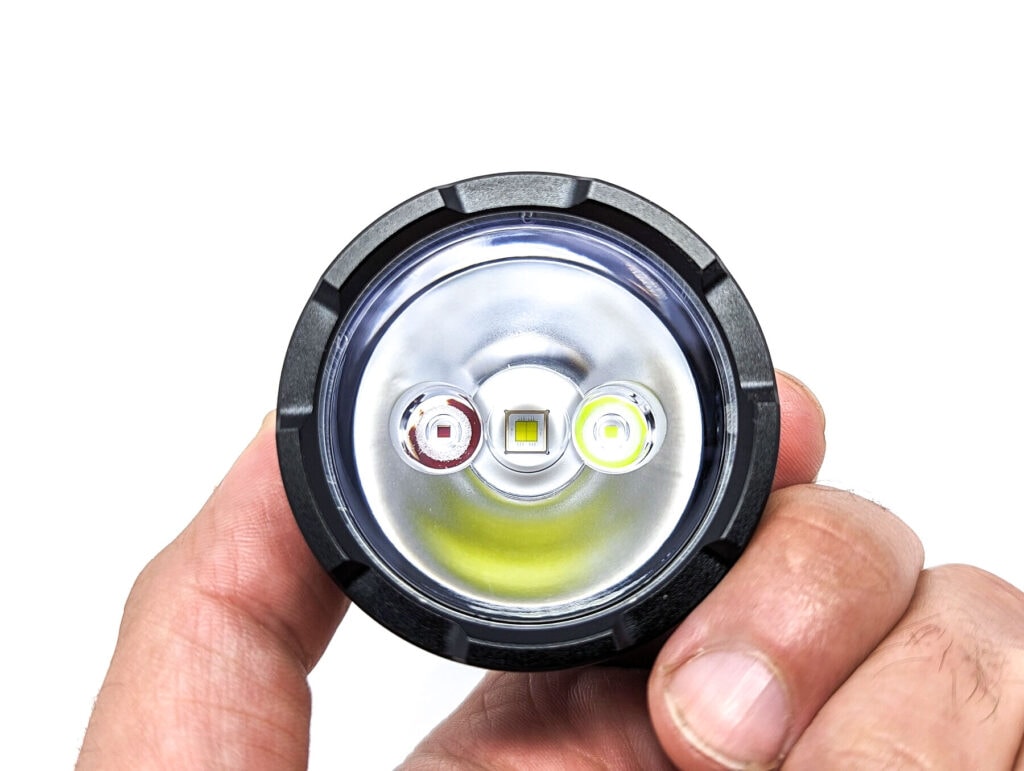
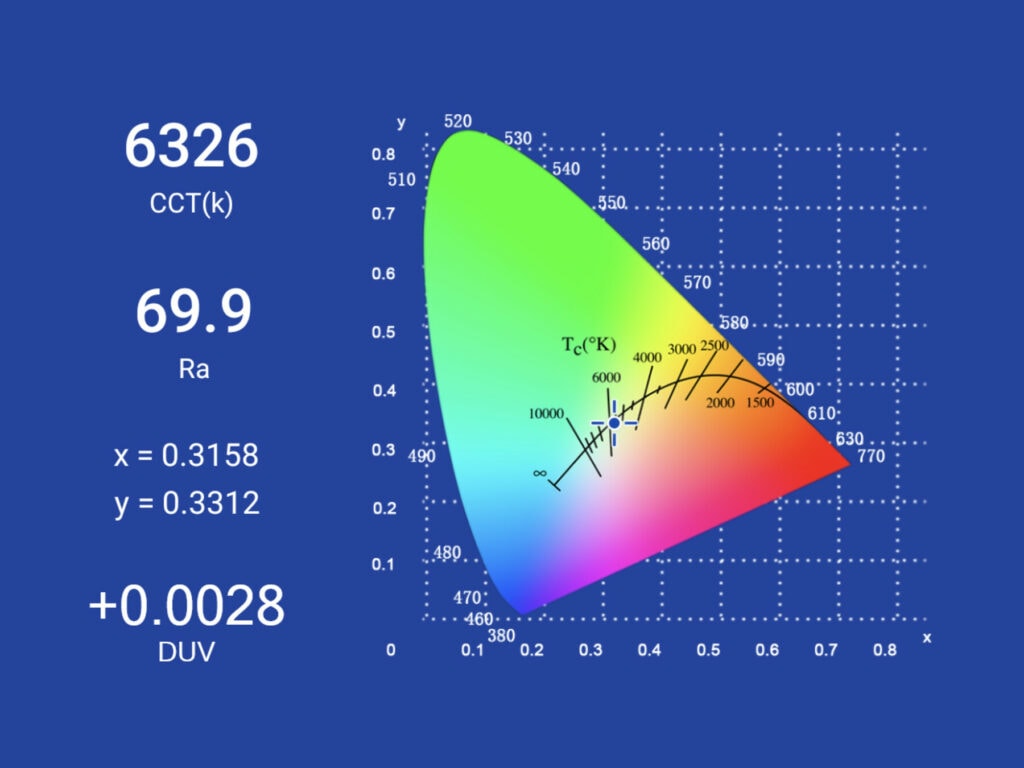
Dimensions and its competition
Dimensions:
| Fenix HT32 | Millimeters | Inches |
|---|---|---|
| Length | 165 mm | 6.5 in |
| Head diameter | 52 mm | 2.0 in |
| Body diameter | 25 mm | 1.0 in |
Dimensions are rounded to the nearest millimeter, and to the nearest tenth of an Inch.
Weight:
| Fenix HT32 | Weight in grams | Weight in oz |
|---|---|---|
| Without battery: | 185 g | 6.5 oz |
| With battery | 258 g | 9.1 oz |
Weight is rounded to the nearest gram, and to the nearest tenth of an Oz.
Flashlight size comparison with its competition:
Group 1: Unbranded (Sofirn) C8, Fenix HT32, Convoy M21D
Group 2: Cyansky H5GT, Fenix HT32, Speras TH12
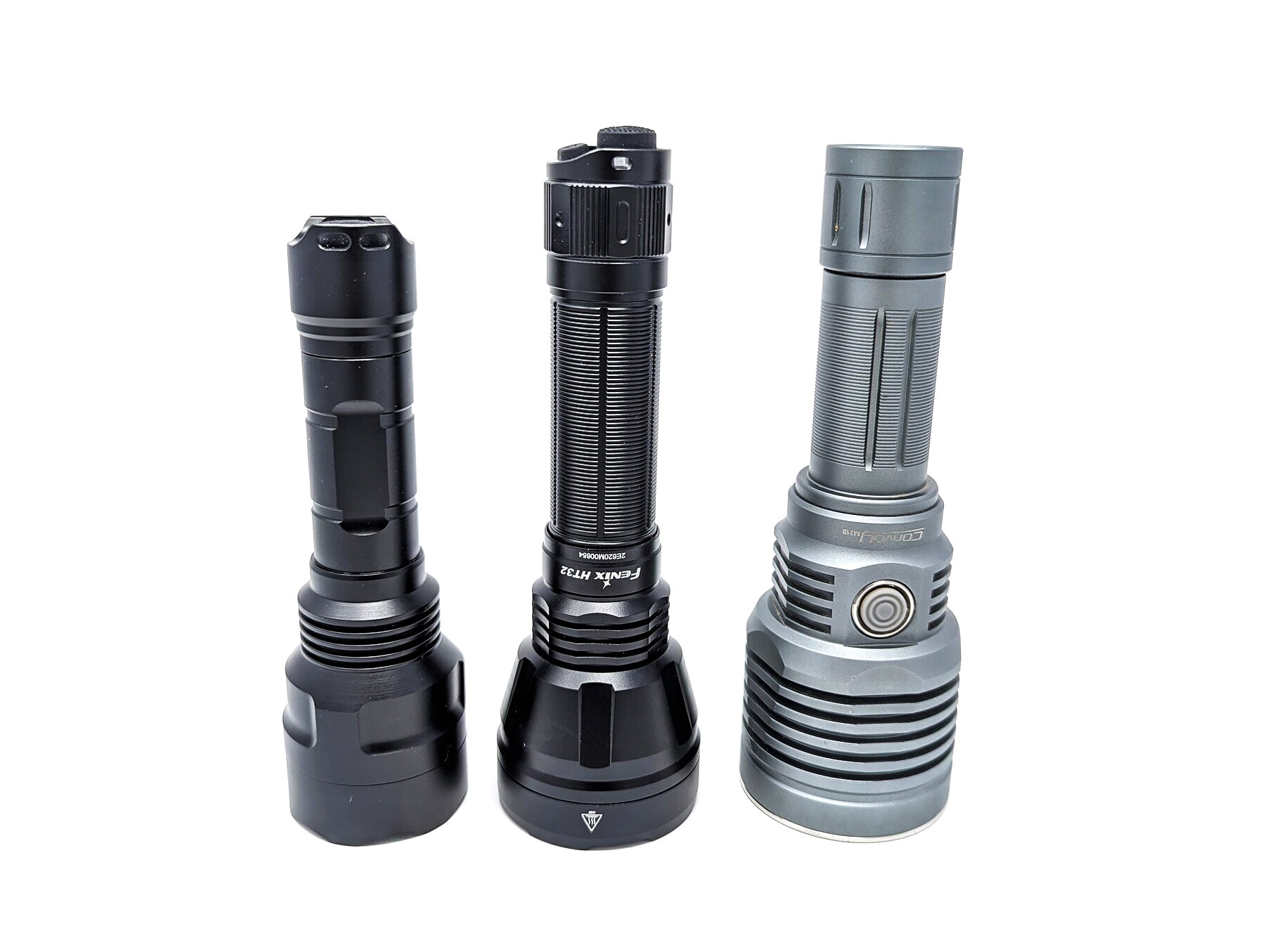
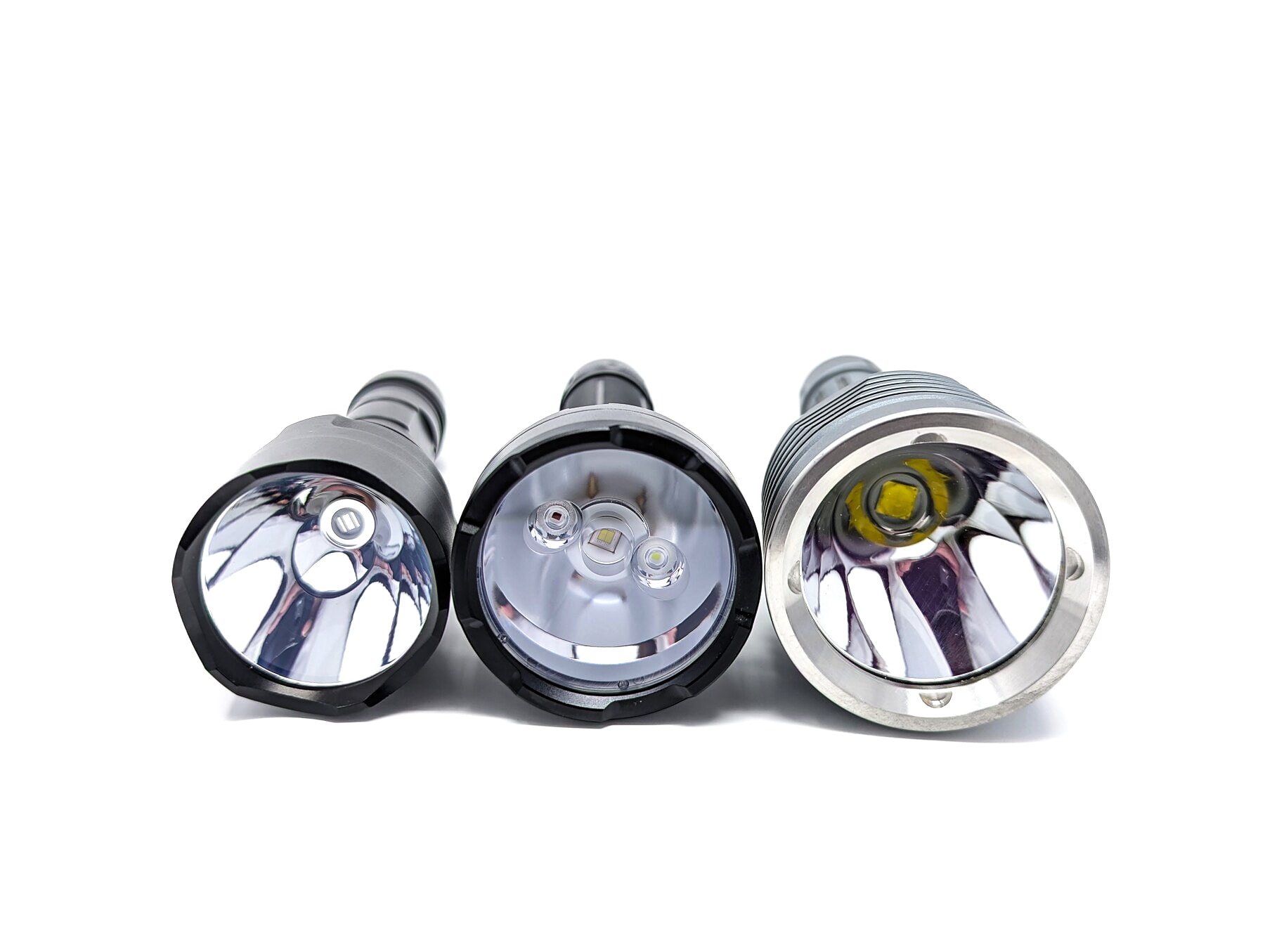
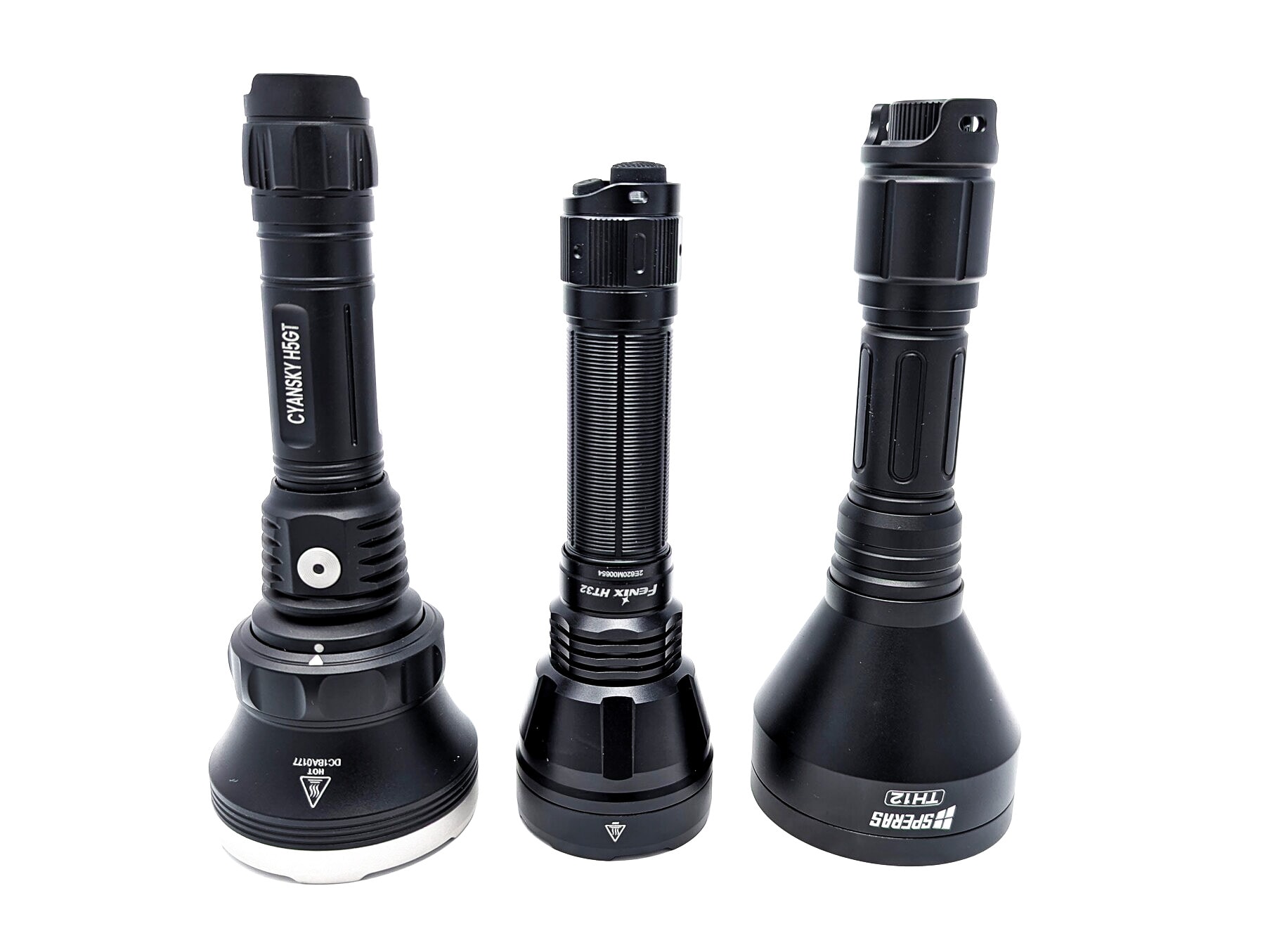
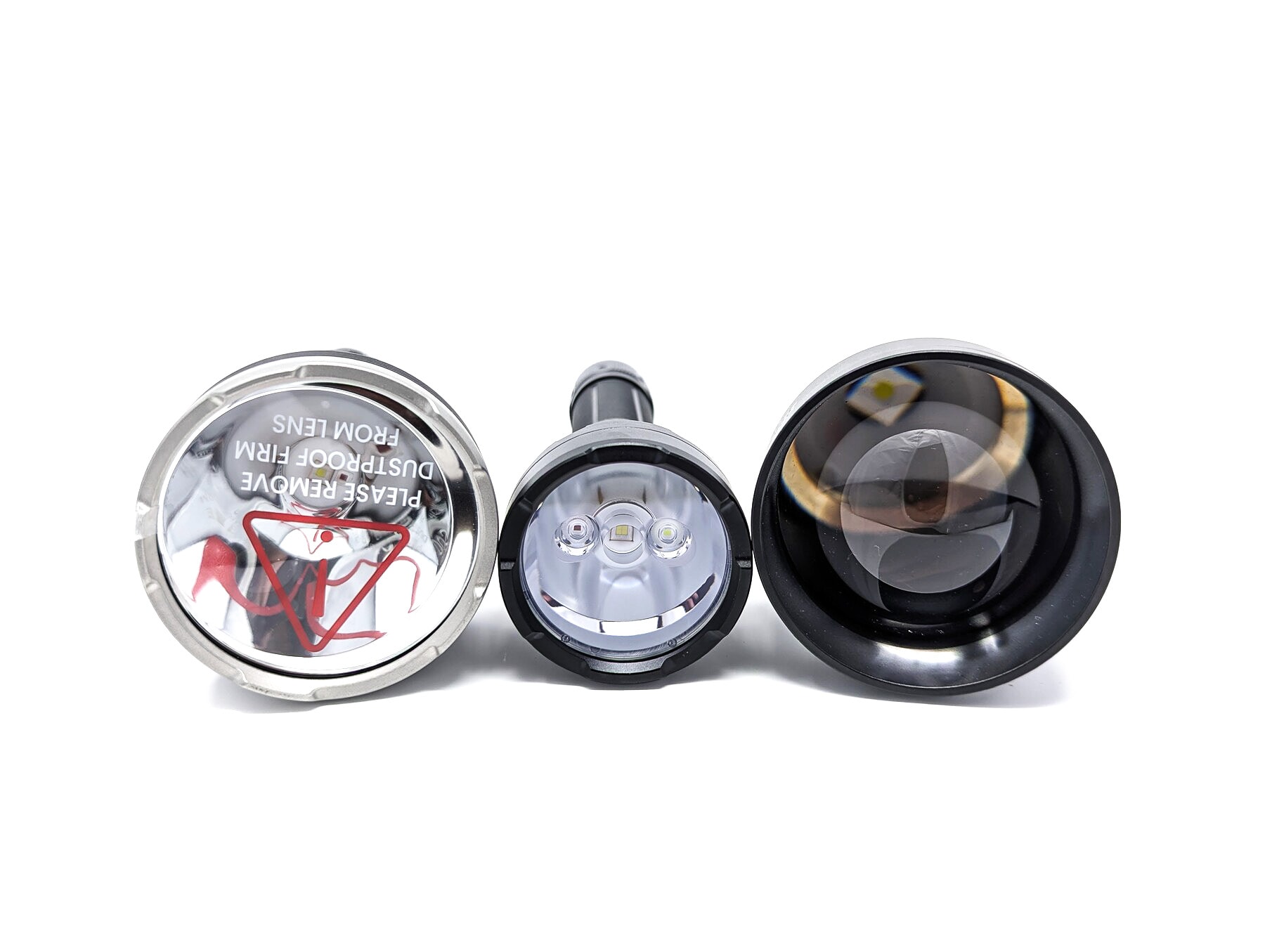
Fenix HT32 UI: User Interface and Driver
The Fenix HT32 employs two switches: a forward-clicky “tactical” switch for on-off duties, and a “functional” e-switch for mode changes. There aren’t a ton of modes or options, which is a good thing I suppose, because you really don’t want to overcomplicate a hunting light.
Available modes:
- White: Low, Medium, High, Turbo
- Red: Low, High
- Green: Low, High
Available blinky modes:
- Strobe (white)
From OFF:
- Tactical switch, press and hold: momentary on
- Tactical switch, single click: on
- Functional switch, press and hold: strobe
From ON:
- Tactical switch, single click: off
- Functional switch, single click: change brightness
- Functional switch, press and hold: change color (white > red > green)
Mode memory:
- Yes, there is memory for both color and brightness level
Shortcuts:
- To Strobe: press and hold the functional switch from off
Low voltage warning/protection:
- The output will step down when the battery gets low
- Eventually the HT32 will blink 3 times every 5 minutes to remind the user to recharge the flashlight
Strobe/blinkies
- Strobe, accessed by holding the functional switch from off
Lock-out mode:
- No electronic lockout
- Can quarter-turn the tailcap for physical lockout
PWM
- PWM was not detected
Additional/summary info on the UI:
- The UI is very simple with no real shortcuts, just like it should be
- My only little complaint about the UI is the strobe mode – I don’t need that in a hunting flashlight. I would love to have seen that shortcut activate white-low or red-low, or maybe even Turbo.
Fenix HT32 Charging and batteries
The Fenix HT32 comes with a Fenix-branded 5000 mAh 21700-format battery. The battery has built-in USB-C charging. Fenix included a USB-A to USB-C cable, and I’ve confirmed that the battery is also compatible with C-to-C charging. I observed a 6.9W charge rate, which completely filled the battery is 3h 35min.
Despite having springs at both ends, shorter unprotected cells do not make contact and will not work.
| Charge type | Fits | No fit | Charge time |
|---|---|---|---|
| Flashlight with onboard USB-C | Long, protected 21700 | Shorter, flat-top 21700 like Samsung 40T and Vapcell T50 | 3h 35min |
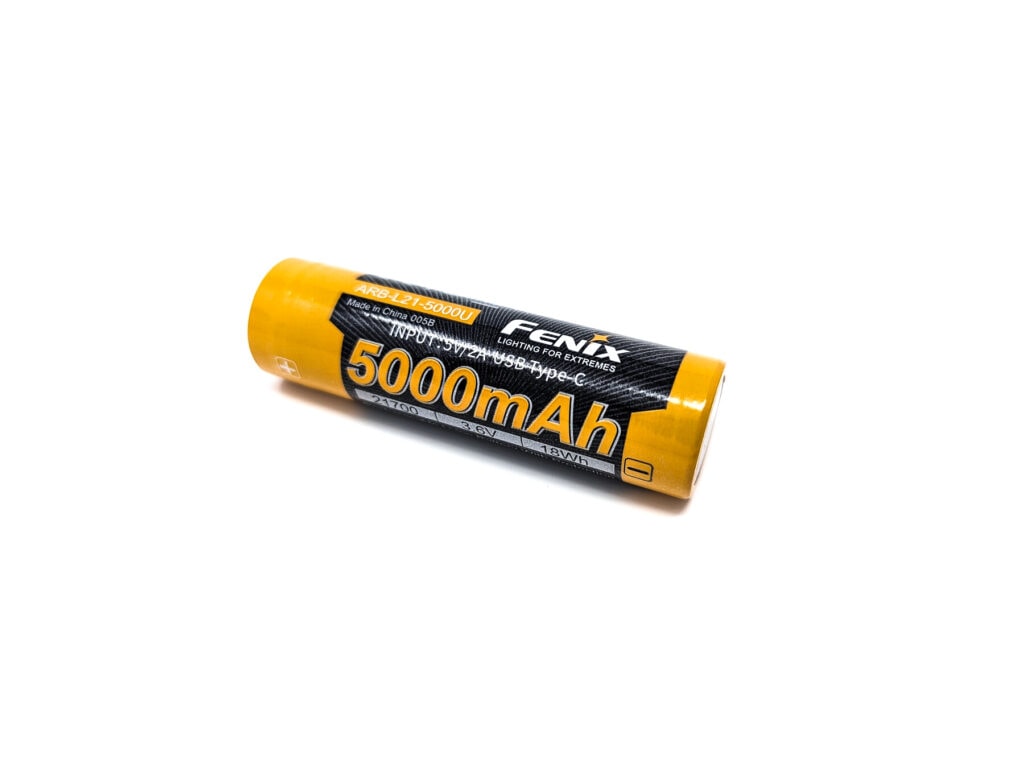
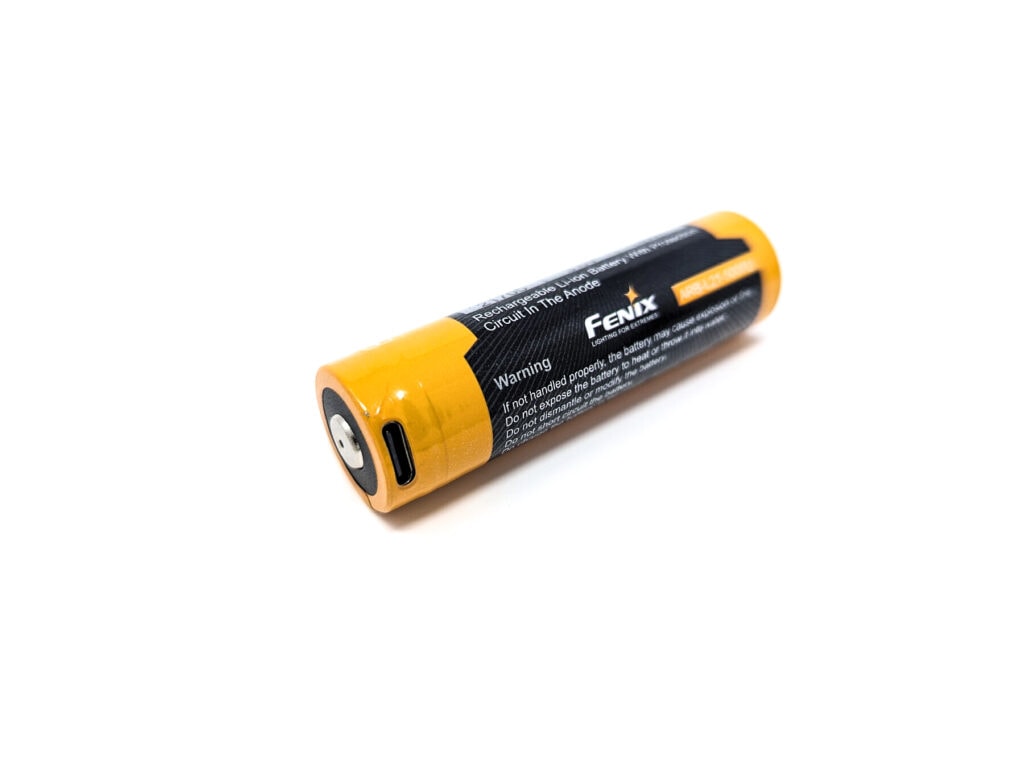
Performance test
Lumen measurements
How Lumens are Measured: Understanding ANSI FL1 Standards How Lumens are Measured: Understanding ANSI FL1 Standards: The ANSI FL1 standards specify that output in lumens should be measured 30 seconds after turning on, as this is the standardized time for measuring brightness according to the industry standard. This is why we focus on this part in our measurements. The ANSI FL1 standards require an ambient temperature of 22 ± 3°C. We record the ambient the ambient temperature to identify potential reasons for any observed discrepancies.Lux was measured by a UNI-T UT383 BT at 5 meters. Lumens were measured in a homemade lumen tube using a VEML7700 sensor, calibrated with a calibration light provided by 1Lumen. The included Fenix battery was used for testing.
I wasn’t able to measure the current drain because of the dual-switch tailcap design.
| Mode | Specs | @turn on | @30 sec | @10 minutes |
|---|---|---|---|---|
| Low | 50 lm | 49 lm | 50 lm | – |
| Med | 350 lm | 397 lm | 395 lm | 392 lm |
| High | 1000 lm | 1163 lm | 1146 lm | 1112 lm |
| Turbo | 2500 lm | 2953 lm | 2666 lm | 997 lm |
| Red, Low | 150 lm | 98 lm | 96 lm | – |
| Red, High | 400 lm | 345 lm | 326 lm | 156 lm |
| Green, Low | 350 lm | 427 lm | 426 lm | – |
| Green, High | 1400 lm | 1605 lm | 1552 lm | 930 lm |
| Turbo at 3.6V | 1150 lm | 1133 lm | – |
Parasitic drain:
- N/A
In general, my measurements line up pretty close with Fenix’s specs. That’s not much of a surprise, though – Fenix tends to be very honest with their claims (at least from my experiences).
The HT32 uses “intelligent overheat protection” which seems to do a pretty good job of fulfilling Fenix’s goal of keeping the temperature under 65°C.
Fenix HT32 Battery Life: Runtime graphs
How Runtimes are Measured: Understanding ANSI FL1 Standards About ANSI FL1 runtime standards: The runtime is measured until the light drops to 10% of its initial output (30 seconds after turning on). This does not mean that the flashlight is not usable anymore. The last column shows how long the light actually works till it shuts off. If there is a + symbol, it means that the test was stopped at that particular point, but the light was actually still running. This happens on certain occasions, with certain drivers, firmware, or batteries.| Mode | Specified runtime | Measured runtime ANSI | Time till shut off |
|---|---|---|---|
| Low | 29h | – | – |
| Med | 8h | 7h 46min | 9h 17min |
| High | 2h 30min | 2h 25min | 6h 17min |
| Turbo | 1h 50min | 2h 5min | 6h 7min |
| Red, Low | 4h 50min | – | – |
| Red, High | 3h 15min | 3h 16min | 3h 16min |
| Green, Low | 6h | – | – |
| Green, High | 2h 30 min | 2h 46min | 2h 46min |
Just like in the lumen output testing, the runtime measurements are really close to Fenix’s claims. The white modes petered along for hours at 9 lumens until it finally shut off. Red and green modes were quite different – the HT32 shut off abruptly.
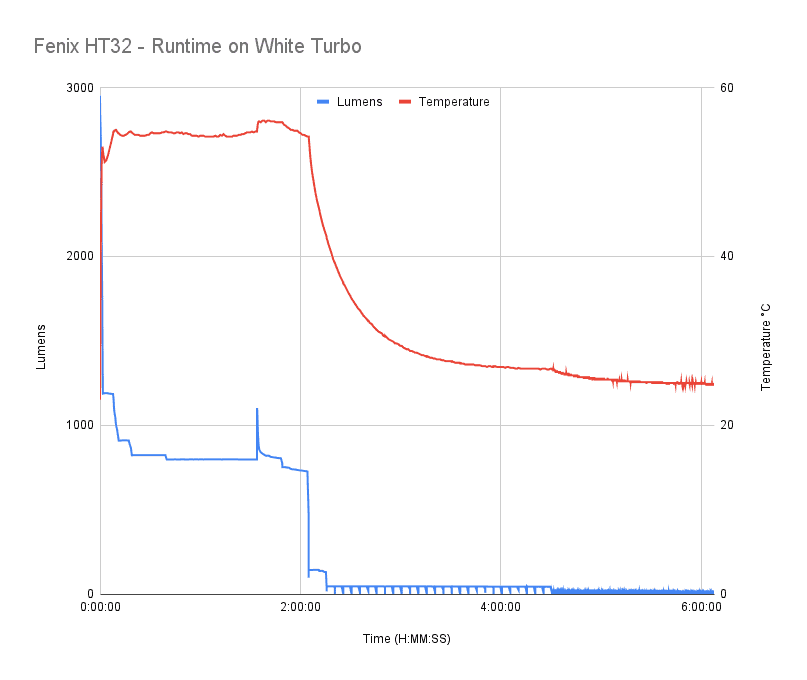
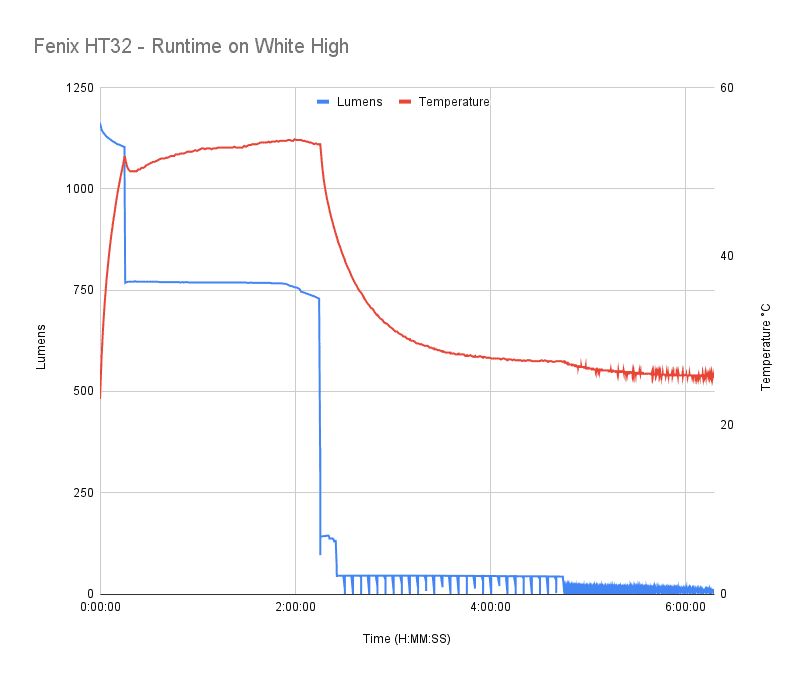
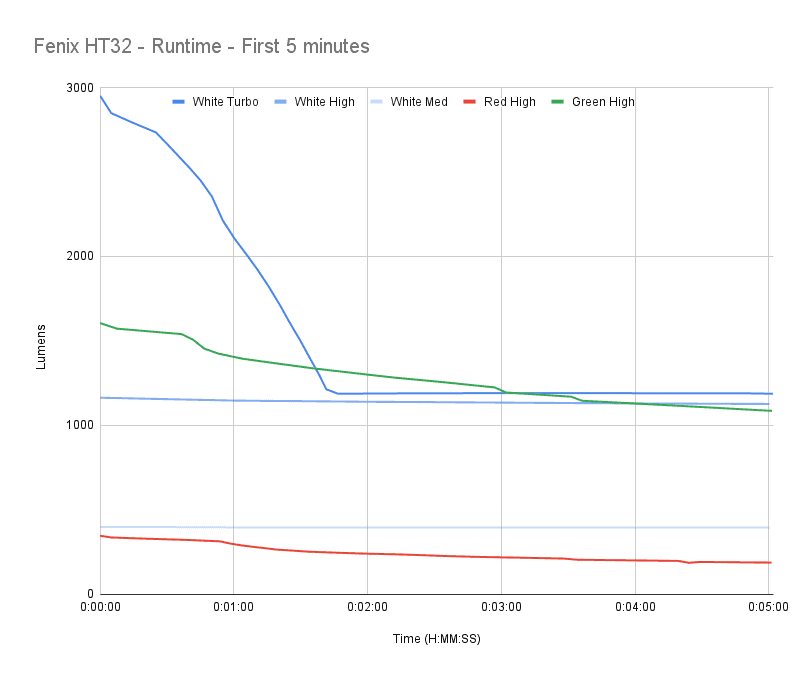
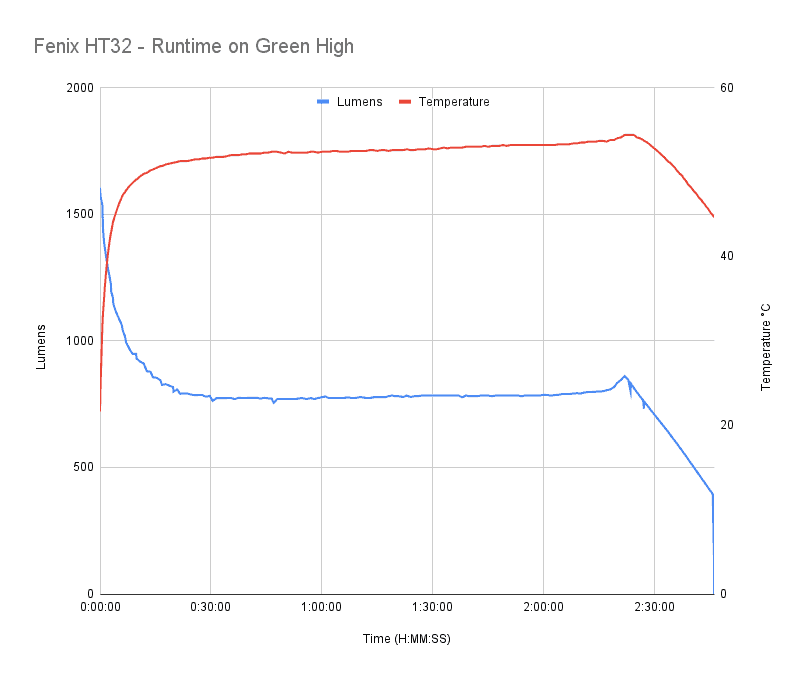
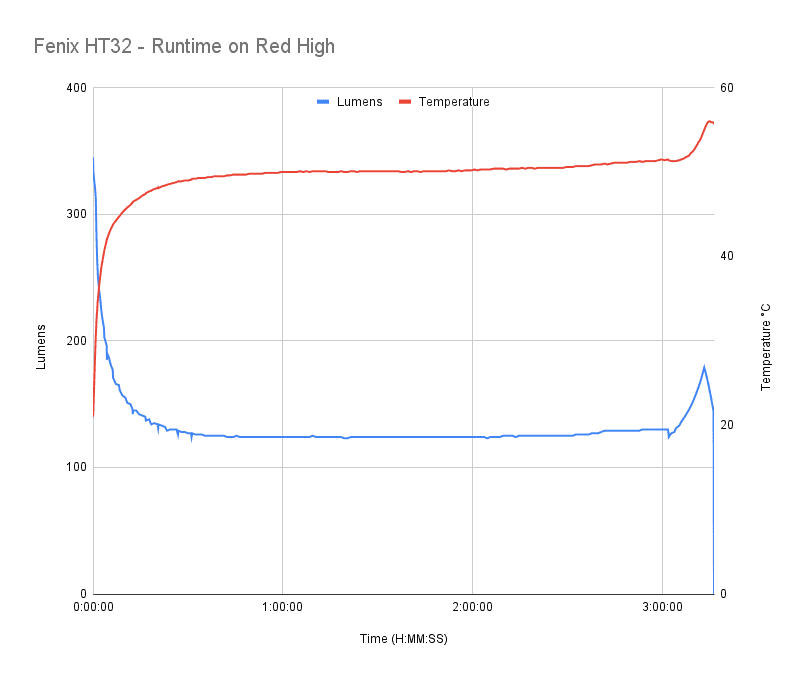
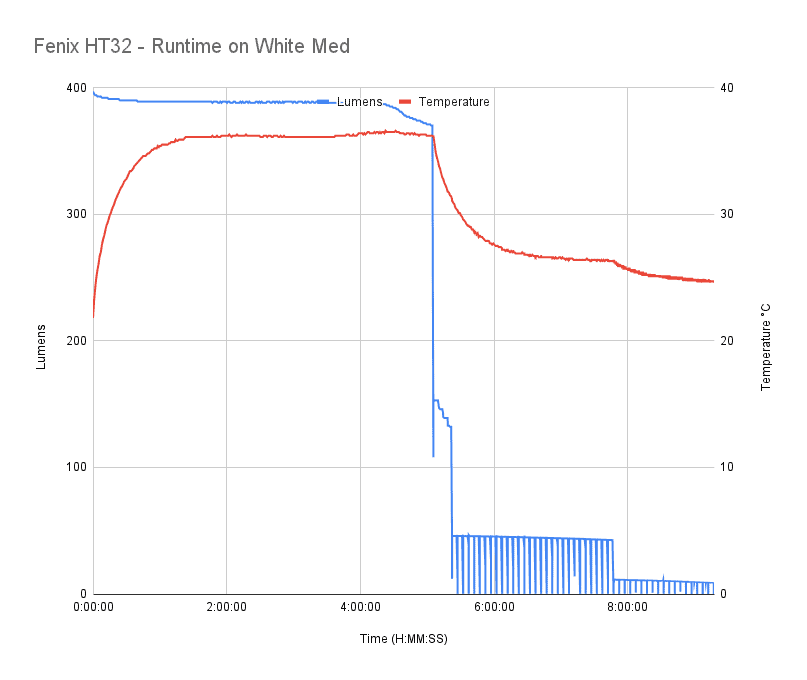
Peak beam intensity and beam distance measurements
About Peak beam intensity: Understanding ANSI FL1 Standards About peak beam intensity The calculated value of distance in meters at which the flashlight produces a light intensity of 0.25 lux. (0.25 lux is about the brightness of a full moon shining on an object). This means that the intensity has decreased so much, it becomes difficult to see darker objects, or objects that don’t reflect light. The columns ‘Meters’ and ‘Yards’ use rounded numbers.Intensity was measured at 5 meters after being turned on for 30 seconds. A UNI-T UT383 BT lux meter was used.
| Mode | Specs | Candela measured | Meters | Yards |
|---|---|---|---|---|
| Low | 2,300 cd | 2,075 cd | 91 m | 100 yd |
| Med | 15,000 cd | 14,000 cd | 237 m | 259 yd |
| High | 43,200 cd | 41,500 cd | 407 m | 446 yd |
| Turbo | 101,000 cd | 96,875 cd | 622 m | 681 yd |
| Red, Low | 1,100 cd | 1,075 cd | 66 m | 72 yd |
| Red, High | 3,120 cd | 2,725 cd | 104 m | 114 yd |
| Green, Low | 2,500 cd | 2,175 cd | 93 m | 102 yd |
| Green, High | 11,000 cd | 7,825 cd | 177 m | 193 yd |
Overall, my intensity measurements were pretty close to spec. The white tests were within a reasonable margin of error, red was pretty close, and green seemed to fall a bit shy of Fenix’s claim. These intensity figures highlight about the only drawback I can think of with Fenix’s unique TIR setup. That is, while the white LED is very focused, the TIR sections for red and green are pretty small and so those don’t throw nearly as far as white.
Beamshots
Camera settings and distance:
Beam shots of the building are taken at 30 m (33 yd) using a Pixel 7 set to ISO 800 with 1/10 second exposure time
Beamshots of the following flashlights compared:
- Fenix HT32
- Cyansky H5GT
- Speras TH12
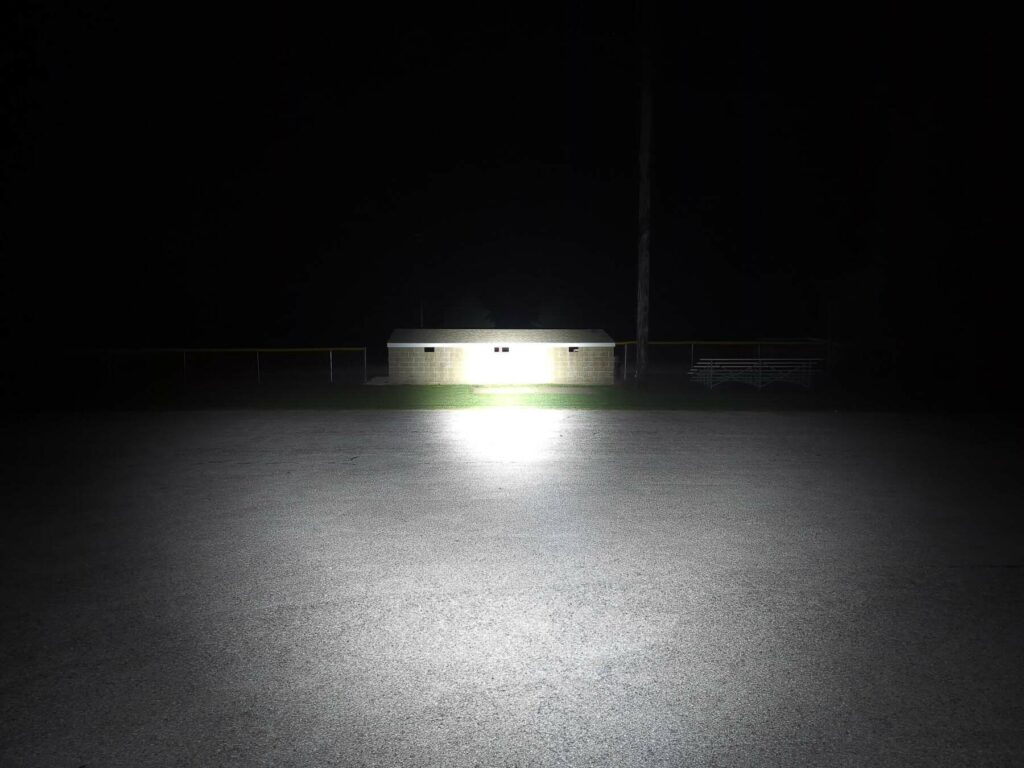
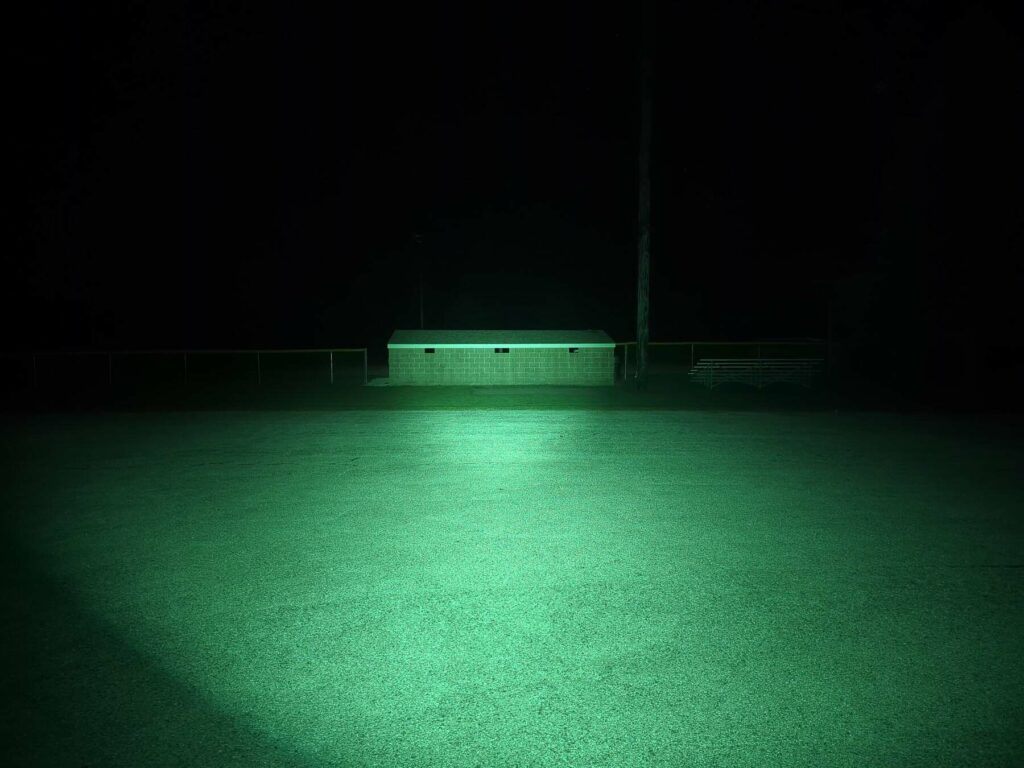
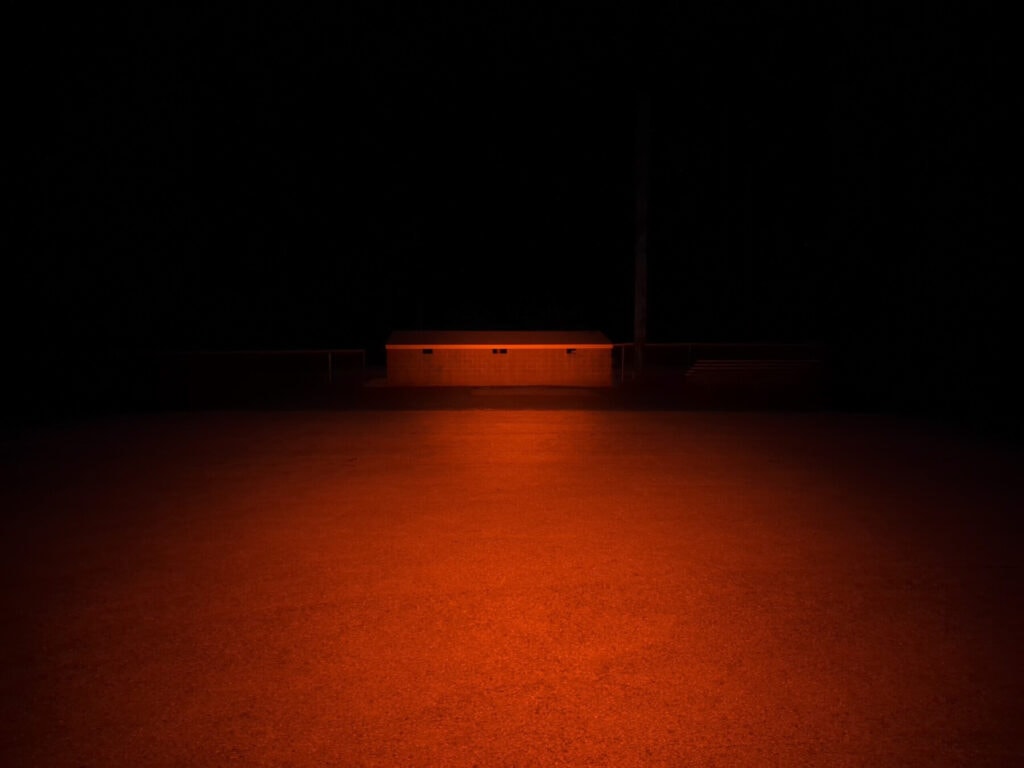
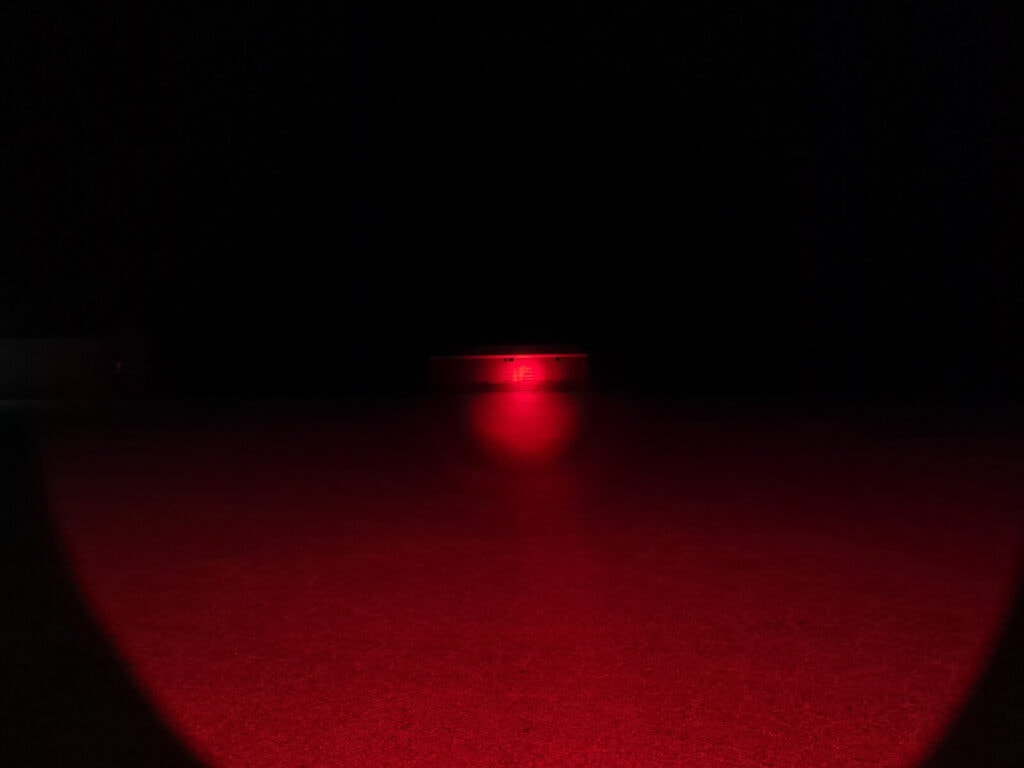
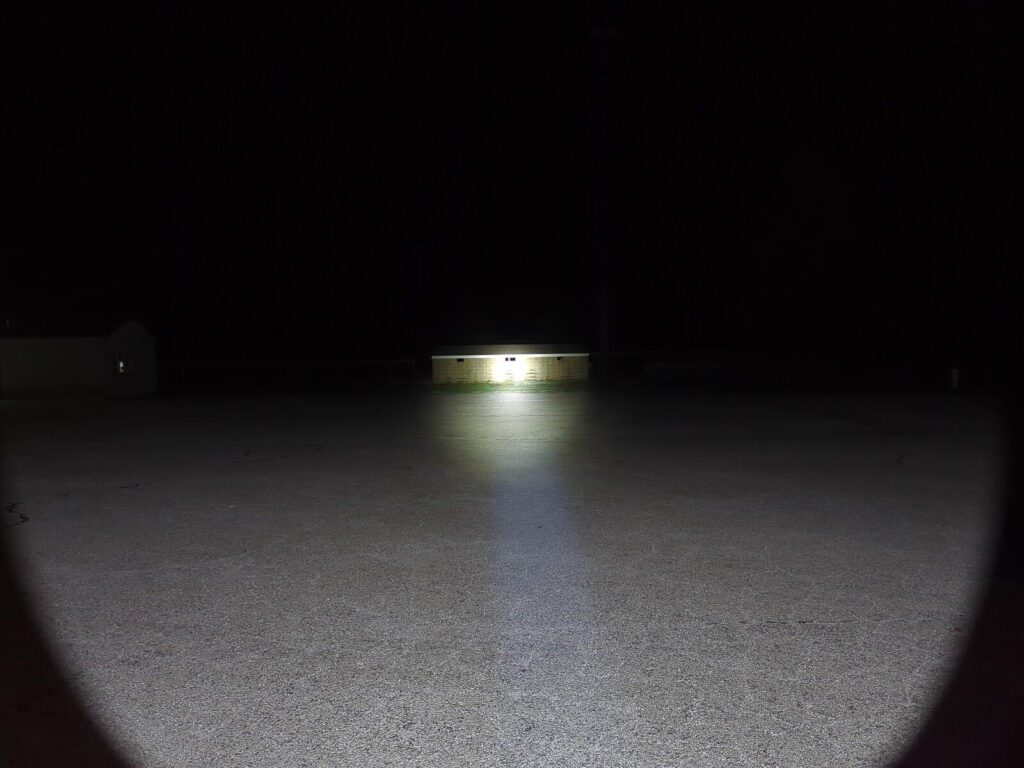
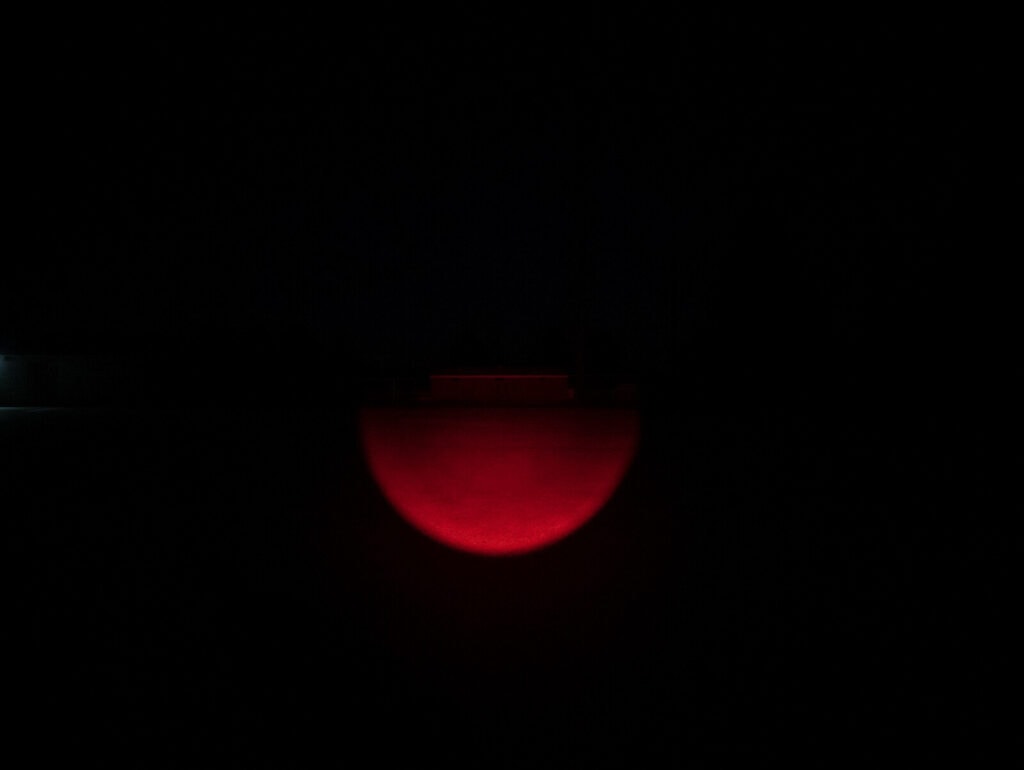
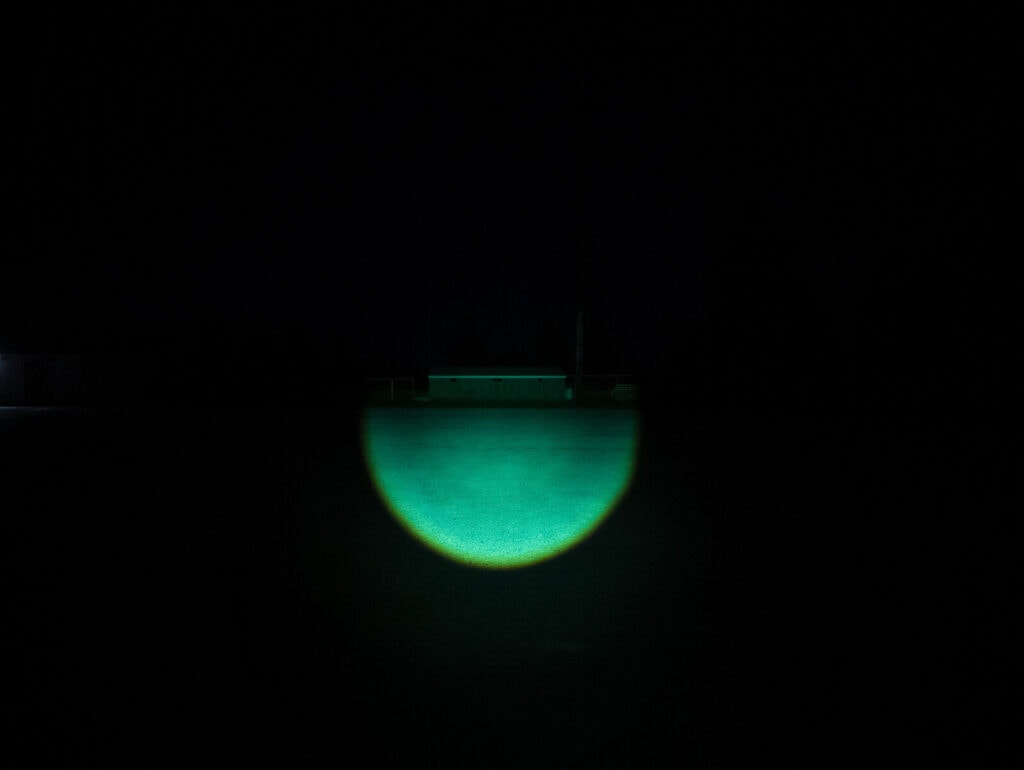
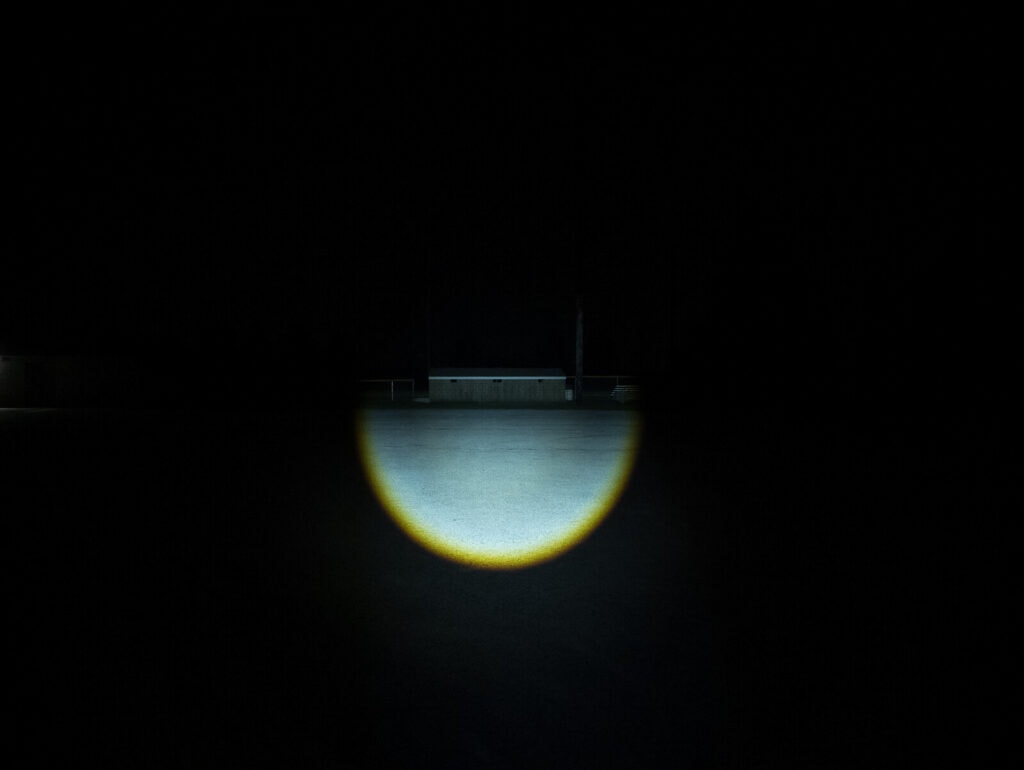
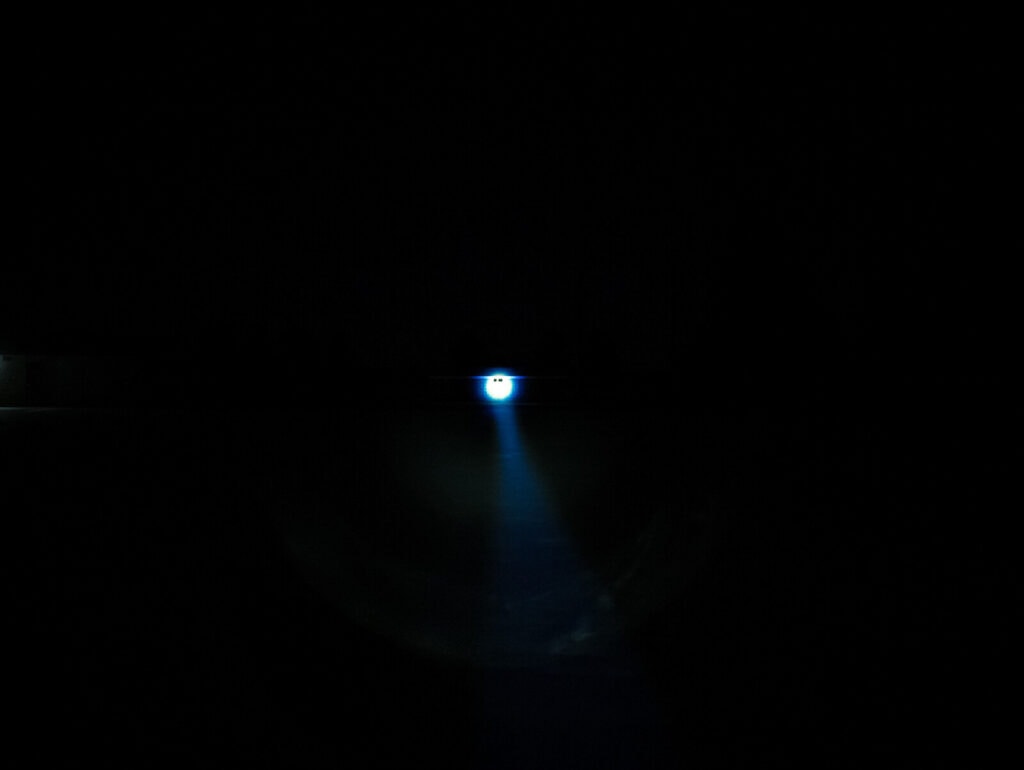

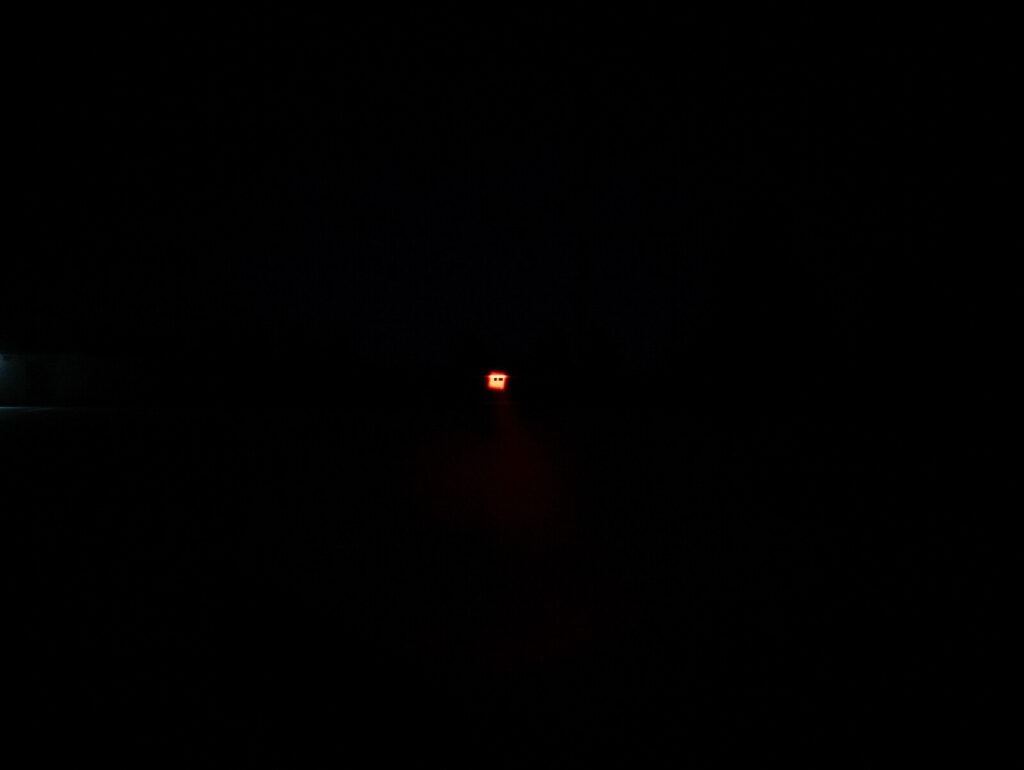
Disclaimer: This flashlight was sent to us for review at no cost by Fenix Lighting US. We have not been paid to review, nor have we been holding back on problems or defects.
Final Verdict
Pros
- Great build quality
- On-the-fly color changes
- Easy-to-use UI
- Effective thermal regulation
Cons
- Unnecessary strobe mode
- No built-in charging (just on the battery)
- Red and green are less intense
Explanation on star ratings:
1: Avoid: a match would be a better choice – 2: Poor: significant defect or issues; almost unusable – 3: Average: some defects or issues; but still usable 4: Good: recommended (minor issues) – 5: Great: highly recommended

4.5 stars: ★★★★⋆
While our star rating provides a reliable indicator, we encourage you to read the full review to make an informed decision based on your own needs and preferences.
I’ve seen some pretty interesting hunting flashlights lately, with the Fenix HT32 being the most recent. As a good hunting light should, it features white, red, and green modes – and projects them with a very unique TIR lens. Unfortunately that lens highly favors the white channel when it comes to throw/intensity, but the red and green modes are still very functional. As long as you’re not looking to do night hunts past 100 yards or so, you should be covered. If you’re in the market for a new, reliable hunting light and don’t need crazy distance with red/green, the new Fenix HT32 is definitely worth a look.
Buy your Fenix HT32 at a discount
Get 10% off every purchase at Fenix Lighting US, by using our exclusive 1lumen discount code: 1lumen10
1lumen selects and reviews products personally. We may earn affiliate commissions through our links, which help support our testing.